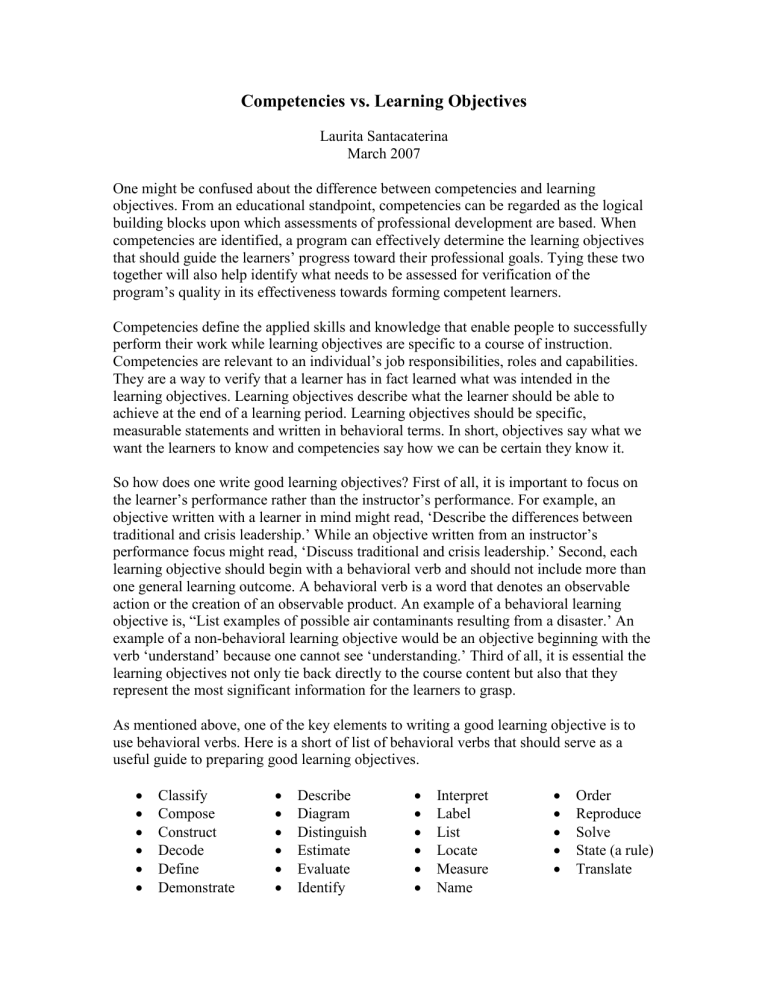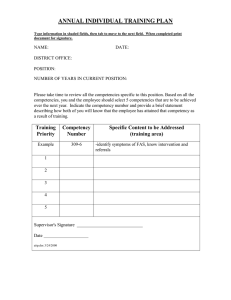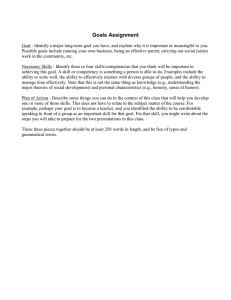
Competencies vs. Learning Objectives Laurita Santacaterina March 2007 One might be confused about the difference between competencies and learning objectives. From an educational standpoint, competencies can be regarded as the logical building blocks upon which assessments of professional development are based. When competencies are identified, a program can effectively determine the learning objectives that should guide the learners’ progress toward their professional goals. Tying these two together will also help identify what needs to be assessed for verification of the program’s quality in its effectiveness towards forming competent learners. Competencies define the applied skills and knowledge that enable people to successfully perform their work while learning objectives are specific to a course of instruction. Competencies are relevant to an individual’s job responsibilities, roles and capabilities. They are a way to verify that a learner has in fact learned what was intended in the learning objectives. Learning objectives describe what the learner should be able to achieve at the end of a learning period. Learning objectives should be specific, measurable statements and written in behavioral terms. In short, objectives say what we want the learners to know and competencies say how we can be certain they know it. So how does one write good learning objectives? First of all, it is important to focus on the learner’s performance rather than the instructor’s performance. For example, an objective written with a learner in mind might read, ‘Describe the differences between traditional and crisis leadership.’ While an objective written from an instructor’s performance focus might read, ‘Discuss traditional and crisis leadership.’ Second, each learning objective should begin with a behavioral verb and should not include more than one general learning outcome. A behavioral verb is a word that denotes an observable action or the creation of an observable product. An example of a behavioral learning objective is, “List examples of possible air contaminants resulting from a disaster.’ An example of a non-behavioral learning objective would be an objective beginning with the verb ‘understand’ because one cannot see ‘understanding.’ Third of all, it is essential the learning objectives not only tie back directly to the course content but also that they represent the most significant information for the learners to grasp. As mentioned above, one of the key elements to writing a good learning objective is to use behavioral verbs. Here is a short of list of behavioral verbs that should serve as a useful guide to preparing good learning objectives. Classify Compose Construct Decode Define Demonstrate Describe Diagram Distinguish Estimate Evaluate Identify Interpret Label List Locate Measure Name Order Reproduce Solve State (a rule) Translate Additional Information on Creating Learning Objectives In 1956, Benjamin Bloom headed a group of educational psychologists who developed a classification of levels of intellectual behavior important in learning. This classification of levels is called Bloom’s Taxonomy. It is the most widely used system of its kind in education. Bloom’s Taxonomy divides educational objectives into three "domains:" affective, psychomotor, and cognitive. Within each domain there are different levels of learning. Traditional education tends to emphasize the skills in the cognitive domain. Bloom identified six levels within the cognitive domain, from the simple recall or recognition of facts (knowledge), as the lowest level, through increasingly more complex and abstract mental levels to the highest level that is classified as evaluation. Here is a table illustrating the different levels of the cognitive domain as identified by Bloom’s Taxonomy. The lower levels require less in the way of thinking skills. As one moves down the hierarchy, the activities require higher level thinking skills. Verb examples that represent intellectual activity on each level are also listed. This list can serve as a valuable tool to use when creating learning objectives, assessments and even competencies. Cognitive Verbs Used for Objectives Domain Levels Lowest Knowledge level define, memorize, repeat, record, list, recall, name, relate, collect, label, specify, cite, enumerate, tell, recount Comprehension restate, summarize, discuss, describe, recognize, explain, express, identify, locate, report, retell, review, translate Application exhibit, solve, interview, simulate, apply, employ, use, demonstrate, dramatize, practice, illustrate, operate, calculate, show, experiment Higher Analysis levels interpret, classify, analyze, arrange, differentiate, group, compare, organize, contrast, examine, scrutinize, survey, categorize, dissect, probe, inventory, investigate, question, discover, text, inquire, distinguish, detect, diagram, inspect Synthesis compose, setup, plan, prepare, propose, imagine, produce, hypothesize, invent, incorporate, develop, generalize, design, originate, formulate, predict, arrange, contrive, assemble, concoct, construct, systematize, create Evaluation judge, assess, decide, measure, appraise, estimate, evaluate, infer, rate, deduce, compare, score, value, predict, revise, choose, conclude, recommend, select, determine, criticize 2 More on Competencies vs. Learning Objectives All objectives and competencies should be written in specific, measurable and behavioral terms. However, as mentioned earlier, competencies and objectives are different. Their difference lies in the level at which they are written. Competencies are more complex (higher level) than learning objectives. One competency generally requires a multitude of applied skills and knowledge while learning objectives are more specific and generally relate to one learning outcome. In short, one learning objective does not equal one competency. Here are some examples of competencies and learning objectives relating to the competency: Example 1 Competency: Utilizes appropriate methods for interacting sensitively, effectively, and professionally with persons from diverse cultural, socioeconomic, educational, racial, ethnic and professional backgrounds, and persons of all ages and lifestyle preferences (competency from: Council on Linkages Between Academia and Public Health Practice) Learning objectives from a course that relate to the above competency: Describe the demographic trends and epidemiological trends related to diverse populations in the United States and abroad Compare and contrast diversity and cultural competency in the public health context Identify a framework to design culturally competent public health care services for diverse populations In example 1, one can see that the person would need to achieve several objectives in order to achieve the competency. It is also important to keep in mind that this list of objectives is not a complete list of objectives needed to reach competency. The purpose of this example is to simply demonstrate how a learning objective can be written to tie back to a competency. For example, in order to “utilize appropriate methods for interacting sensitively, effectively…” it would be important for the person to be able to “describe the demographic trends and epidemiological trends related to…” It would also be important for the person to be able to “identify a framework to design culturally competent public health care…” etc. Example 2 Competency: Develops and adapts approaches to problems that take into account cultural differences (competency from: Council on Linkages Between Academia and Public Health Practice) Learning objectives from a course that relate to the above competency: Develop an action plan at the level of the individual, group, and organization by strengthening diagnostic skills 3 Use data collected in the diagnostic phase to develop an action plan at the individual, group, and organization level Present individual, group, and organization action plans for feedback Example 2 also illustrates how one competency would require several objectives to successfully achieve this competency. Again, it is also important to keep in mind that this list of objectives is not a complete list of objectives needed to reach competency. The purpose of this example is to once more demonstrate how a learning objective can be written to tie back to a competency. For example, in order to “develop and adapt approaches to problems…” it would be important for the person to be able to “develop an action plan at the level of the individual, group…” It would also be important for the person to be able to “use data collected in the diagnostic phase…” etc. In summary, competencies define the applied skills and knowledge that enable people to successfully perform their work while learning objectives are specific to a course of instruction. Both should be written in specific, measurable and behavioral terms. Competencies are generally written at a higher level than a learning objective because they require more complex levels of performance. Since traditional education tends to emphasize skills in the cognitive domain, one can use the six different levels of Bloom’s Taxonomy as a valuable tool when creating both competencies and learning objectives. Reference: Bloom, Benjamin S. and David R. Krathwohl. (1956). Taxonomy of educational objectives: The classification of educational goals, by a committee of college and university examiners. Handbook 1: Cognitive domain. New York, Longmans. 4



